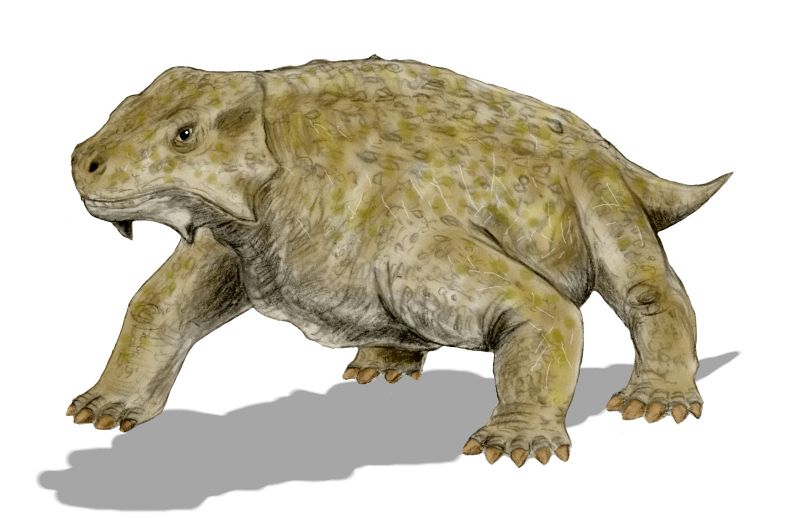- Bradysaurus
Taxobox
name = "Bradysaurus"
fossil_range =Permian (Capitanian )

image_caption = "Bradysaurus baini"
regnum =Animal ia
phylum =Chordata
subphylum =Vertebrata
superclassis =Tetrapoda
classis =Sauropsida /Reptilia
subclassis =Anapsida /Parareptilia
ordo =Procolophonia
familia =Pareiasaur idae
subfamilia = Bradysaurinae
subfamilia_authority = von Huene, 1948
genus = "Bradysaurus"
genus_authority =
Watson, 1914
subdivision_ranks =Species
subdivision =
*"Bradysaurus baini"
*"Bradysaurus seeleyi""Bradysaurus" was a large (2.5 to 3 meters long [8 to 10 ft] ), early and common
pareiasaur , the fossils of which are known from the richly fossiliferousTapinocephalus Assemblage Zone (Capitanian age) of the South AfricanKaroo . Along with the similarly largedinocephalia , the bradysaurs constituted the herbivorousmegafauna of the late Middle Permian Period. In life they were probably slow, clumsy and inoffensive animals, that had evolved a covering of armoured scutes to protect them against their predator enemies, thegorgonopsia ns."Bradysaurus" is the only member of the subfamily Bradysaurinae. It is the most primitive known pareiasaur and can be considered a good ancestral type from which the others developed. Its large dimensions show that, even very early in their evolutionary history, these strange animals had already attained an optimal size. Even later, more advanced forms, like "
Scutosaurus ", were no larger. The advantage of large size was to provide defense against predators and to maintain a stable body temperature (gigantothermy ).Characteristics
The skull was large (about 42 to 48 centimeters long [17 to 19 in] ), broad and rounded at the front. It was coarsely sculptured and knobby, with the sutures between the bones not clearly visible. The marginal teeth were high-crowned, with only a few cusps, which is a primitive characteristic.
The feet were short and broad, the phalangeal count being 2,3,3,3,2 on the fore-foot and 2,3,3,4,3 on the hind. The whole body is protected by dermal scutes, although these are not as thick or heavy as in more advanced forms.
Known Species
Kuhn 1969 lists no fewer than nine species for this genus, but this is certainly an excessive number. Boonstra 1969 distinguishes only four species on the basis of tooth structure, two of which Kuhn places in the genus "Embrithosaurus".
The genera "Brachypareia", "Bradysuchus", "Koalemasaurus", and "Platyoropha" would seem to be synonyms of "Bradysaurus".
The two species are as follows:
"Bradysaurus baini" (Seeley 1892)
:Tapinocephalus zone, Lower Beaufort Beds, Karoo basin, South Africa This is the
type species for the genus. The quadra-jugal region (cheek-bones) were only moderately developed. The snout was broad and rounded and there were 15 or 16 pairs of overlapping teeth in each jaw. This animal could be considered a generic early pareiasaur. According to Lee, 1997, the available material of "B. baini" lacks distinguishing autapomorphies or characteristics."Bradysaurus seeleyi" Haughton and Boonstra 1929
:Tapinocephalus zone, Lower Beaufort Beds, Karoo basin, South Africa. This is a less common form. Boonstra, 1969, considered this a valid species of Bradysaurus and Lee, 1997, considers this animal a sister group to more advanced pareiasaurs. "B. seelyi" seems to be closely related to "Nochelesaurus" and "
Embrithosaurus ". In contrast to the more numerous but similarly sized "B. baini", the cheekbones were heavy and greatly enlarged. There were 19 or 20 pairs of strongly overlapping teeth on each jaw.References
* Boonstra, L. D. 1969, "The Fauna of the Tapinoephalus Zone (Beaufort Beds of the Karoo)," Ann. S. Afr. Mus. 56 (1) 1-73, pp. 29-32
*Edwin H. Colbert , 1965, The Age of Reptiles, The World Naturalist, Weidenfeld and Nicolson, London, pp.52-3
*Barry Cox , R.J.G.Savage,Brian Gardiner ,Dougal Dixon , 1988 "Illustrated Encyclopaedia of Dinosaurs and Prehistoric Animals"
*Carol Lane Fenton andMildred Adams Fenton , 1958, "The Fossil Book", Doubleday & Co., Garden City, New York, p.306
* Kuhn, O, 1969, Cotylosauria, part 6 of "Handbuch der Palaoherpetologie" (Encyclopedia of Palaeoherpetology), Gustav Fischer Verlag, Stuttgart & Portland,
* Lee, MSY (1997), Pareiasaur phylogeny and the origin of turtles. "Zool. J. Linnean Soc.", 120: 197-280External links
* Palaeos [http://www.palaeos.com/Vertebrates/Units/Unit200/200.html#Bradysaurs Bradysaurs]
Wikimedia Foundation. 2010.
